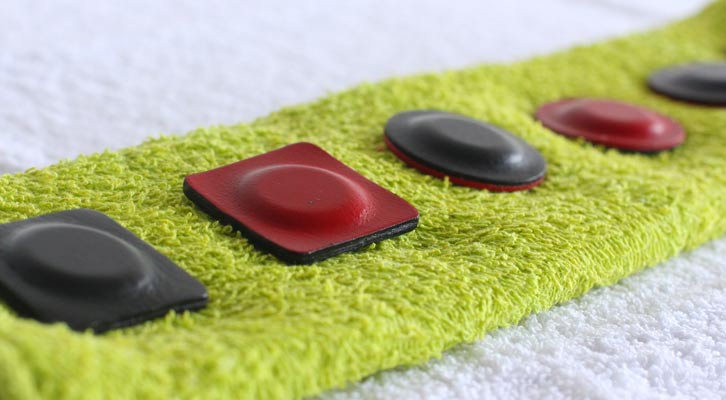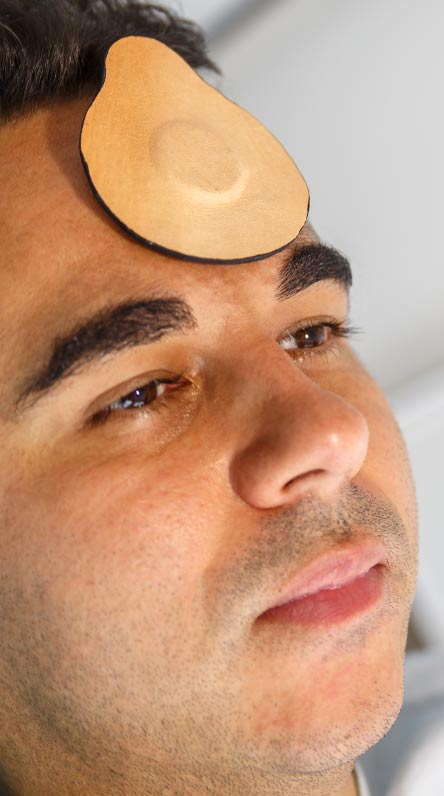Biomagnetic Therapy NYC by Marc Bystock L.Ac.
"Biomagnetic Pair therapy offers tremendous benefit first to help us gain insight into the etiology or root cause of any disorder and serve as a therapeutic system for health, healing, and recovery."
-Marc Bystock L.Ac.
Contact Marc Bystock, Leading Holistic Acupuncturist in NYC for a Free Consultation.
CONTACT MARC
VERIFY YOUR HEALTH INSURANCE
Biomagnetic Therapist Marc Bystock NYC Acupuncturist in Midtown Manhattan NY 10016
Biomagnetic therapy is a game-changing medical modality that differs from other natural therapies but is complementary to them. It is a revolutionary therapy that uses magnets of opposite polarity powered by a gauss of 1000 to 15,000 per magnet. Biomagnetism is sometimes referred to as Biomagnetic Pair Therapy (BMP). Magnets are placed explicitly around the body to produce a healing effect reaching the cellular level.
When medium-strength neodymium magnets are placed in pairs, they improve circulation, optimize the condition of organs and glands, reduce inflammation and support a normal tissue pH of 7.3.
The human body consists of more than 37 trillion cells. Each cell in the body has a negative charge on the outside and a positive charge inside. When inflammation occurs from trauma, infection, or any other cause, damaged cells release inflammatory cytokines, including histamines and prostaglandins. These pro-inflammatory chemicals cause blood vessels to leak into the tissues, causing swelling. In addition, nutrients and oxygen may be reduced, which causes the body's natural electrical flow to become disrupted.
Historically, the earliest recorded use of medical magnets goes back to over 2,000 years ago in ancient Chinese medicine. In a book called the "Yellow Emperor's Book of Internal Medicine" (circa 2000 BC), magnets are referred to in conjunction with the practice of acupuncture. In addition, both the ancient Egyptians and Greeks used magnets for various medical benefits.
According to the Japanese physician and researcher, Kyoichi Nakagawa, MD, Director Isuzu Hospital, Tokyo, who has researched humans and magnets for over 20 years, the earth has been experiencing a magnetic deficiency syndrome for the last 500 plus years.
In addition, most of us in today's modern world spend most of our time living in magnetically shielded buildings and vehicles. He concludes that such a deficiency ultimately produces stiff shoulders, tight back and neck muscles, chest pains, headaches, heaviness of the head, dizziness, insomnia, chronic constipation, general weakness, and disharmony at the cellular level.
Furthermore, most pathogens (viruses, bacteria, fungi, and parasites) thrive in the human body in very acidic or, in some cases, very alkaline environments. For instance, some viruses require a pH of 8.0 to infiltrate a cell wall for replication.
Illness is often associated with changes in the pH of the host organism. These alterations allow pathogens to become installed in the body, causing imbalances at the cellular level and for symptoms to appear. By applying magnets directly where pathogens are located, the biological terrain in which they live is changed in terms of pH and bio-chemical polarity. This action dramatically diminishes the ability of pathogens to survive.
Magnetic fields are found in both humans and microbes. Living organisms are electrically and magnetically charged, responding to magnetic and biochemical imbalances.
Biomagnetic Therapy Video
Call (212) 696-4325 for a
Free Consultation
Biomagnetic Pair Therapy Treatments
The Biomagnetic pair therapy technique makes it possible to support patients who may suffer from a wide variety of disorders, including infectious agents, chronic degenerative, metabolic, autoimmune, psycho-emotional, mental health, and tumor-related diseases, all non-invasively. In addition, biomagnetic therapy can reduce clinical symptoms and potentially reignite a patient back to health.
Post surgically, Biomagnetic therapy can speed up recovery and rehabilitation time, as magnets quickly heal at the cellular and tissue levels.
During a typical session that lasts 90 minutes, over 400 Biomagnetic pairs are scanned throughout the entire body using kinesiology, nerve, and muscle testing, as a biological feedback system. Kinesiology is used to determine the placement of the magnets. Magnets are always placed in pairs as polar opposites creating biological balance. The imbalance to be corrected lies in between the pairs.
A specific Biomagnetic pair consists of two areas that resonate with each other. The first area is acidic and positive. The second region is negative and alkaline. Pathogens, viruses, bacteria, fungus, and parasites usually prefer body regions that are either highly acidic or alkaline. In general, bacteria and parasites favor alkaline body tissue, and the viruses and fungi select acidic tissues to live and grow in. In summation, placing North and South poles of two magnets in a specific manner rectifies the body's pH balance, optimizes healing, and causes the elimination of pathogens.
Dr. Issac Goiz Duran, M.D. of Mexico City, discovered that by improving the pH of specific tissue that lies in resonance with one another, a destabilization of pathogens might occur, creating an intolerable biological environment for them to exist.
Dr. Richard Broeringmeyer, a leading NASA physician, discovered that his astronauts coming back to earth from outer space would exhibit the trait of having one leg shorter than the other, "short leg syndrome."
After years of research, Dr. Broeringmeyer discovered that by administering magnets into the spacesuits of his astronauts, he could alleviate the leg discrepancy response. The leg length difference he discovered came about due to a deficiency in the electromagnetic field in outer space.
Dr. Broeringmeyer lectured on magnetic therapy in Mexico City in the early 1980s, and Dr. Goiz Duran attended his seminar. Eventually, the two collaborated, creating what is today as Biomagnetic Pair therapy. When neodymium magnets are placed in polar opposite pairs, they have a unique ability to benefit the body in many ways, including:
- 1The identification of pathogenic organisms
- Improving microcirculation and systemic blood flow
- Reduction of systemic inflammation
- Moving lymph, heavy metals, toxicity, and excess debris
- Optimizing pH balance for a return to health
- The strengthening of targeted glands, organs, and tissues
- Supports general healing through restoration of acid and alkaline balance
- Helps in healing soft tissue injuries
- Reduces pain
- Promotes a parasympathetic state of calm and relaxation
- Produces a positive impact on neurotransmitters and hormones
- Boosting effect on mental and physical energy
- Disrupting the genetics of opportunistic viruses and other pathogens
- Improves blood viscosity
"My biomagnetism sessions are very relaxing. I feel a difference. During the sessions, based on
my nerve and muscle responses as Marc moved my feet he speculated that my symptoms
may be associated with a specific pathogen and sure enough, when I received my laboratory test results, I found out that he was correct.
I learned that when Marc applies these specific magnets in pairs in certain areas of the body it
increases circulation, strengthens glands and organs, improves the pH, and enables your body to flush out toxins. I always crave water afterwards. I learned a lot from Marc and various issues (eczema is one of them) have shown improvement."
-Jane Lerner
Manhattan, NY
How Do Magnets Work?
Every cell in the human body contains a magnetic charge. The outside of our cells is negatively charged. The inside of our cells is positively charged. Electrical signaling moves around the human body rapidly. Neurons rapidly communicate biochemical information through their axon.
Cell membranes contain proteins that act as ion pumps. Some ions remain inside the cell in a state of rest, and others stay outside the cell. This creates an electrical potential. When neurotransmitters communicate, they reverse the charge on each side of the membrane, moving positive charges inside the cell. We call this process depolarization. When depolarization reaches the end of the neuron, hormones are released to permit further cellular instructions. As the particles are released, the negative charge becomes restored on the inside of the cell. This process is known as repolarization.
Releasing neurotransmitters like dopamine, serotonin, GABA, and many others is an electrical process driven by energy and electromagnetic currents. The heart is an electrical generator of the human body. It's nonstop pumping action that creates a magnetic field around our body. The brain also produces its own electromagnetic field. Blood is an excellent electrical conductor, and the circulatory system creates electrical pulses with every heartbeat. So every cell and organ in the body has an electromagnetic field.
Biomagnetic therapy is a non-invasive therapy that may support individuals with the following conditions:
- Acne
- Allergies
- Anemia
- Anxiety
- Arrhythmia
- Arthritis
- Asthma
- Attention Deficit Disorder
- Autism
- Back, Neck, Joints and Muscle Pain
- Candida
- Carpal Tunnel
- Chronic Fatigue
- Chronic Pain
- Depression
- Diabetes
- Digestive Disorders
- Emotional Issues
- Eczema
- Fatigue
- Fibromyalgia
- Flu
- Fungal Conditions
- Glandular Dysfunctions
- Heartburn
- Herpes
- Hepatitis
- High Cholesterol
- Impotency
- Infertility
- Low Libido
- Lyme's Disease
- Lupus
- Low Energy
- Menopause
- Metabolic Disorders
- Parasites
- PMS
- Psoriasis
- Poor Circulation
- Pulmonary Disorders
- Rheumatism
- Sciatica
- Sexual Disorders
- Shingles
- Sinusitis
- Skin Disorders
- Stress
- Thyroid Dysfunctions
- Traumatic brain injuries
- Ulcers
- And more
Contact NYC Acupuncturist Marc Bystock L.Ac. for Biomagnetic Pair Therapy
Biomagnetic Pair therapy offers tremendous benefit first to help us gain insight into the etiology or root cause of any disorder and serve as a therapeutic system for health, healing, and recovery.
I am proud to offer this incredible therapy to my new and existing patients in the New York City area.
A session takes about ninety minutes. First, the client lies comfortably supine on the treatment table. At the same time, I scan their entire body using kinesiology, muscle, and nerve testing, to understand where to place the polar-opposite magnets around the body. Most patients report feeling very relaxed throughout the entire process.
I'm very passionate about helping my patients to feel better and to optimize their overall health.
If you or anyone that you know may suffer from any of the symptoms named above or any other, I urge you to contact me to schedule your first Biomagnetism appointment.
Please contact me
today!
Additional Links







